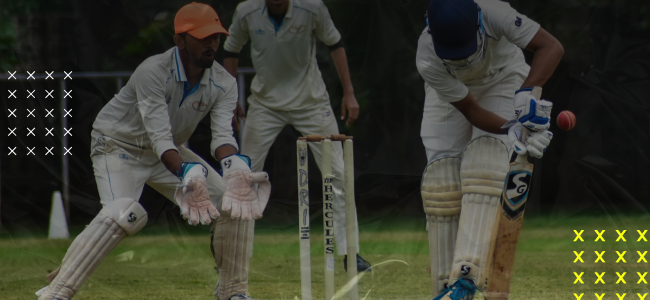In cricket, the run rate can be defined as the average number of runs scored per over by the batting team. The total number of runs scored by the batting side divided by the number of total overs bowled is the formula for calculating a team’s run rate at any stage of the innings.
The batting side can procure runs in the following ways:
- By running between the wickets
- By helping the ball reach the boundary (4s and 6s)
- Extras (No Balls, Wides, Byes, Leg Byes)
- Fines or penalties (Ball hitting the helmet behind the wicket-keeper etc.)
A simple situational example can help us understand how to calculate the run rate in cricket. For example, New Zealand scored 241 runs in 50 overs in the first innings of the 2019 ICC World Cup final whilst losing 8 wickets. To calculate the run rate of the Kiwis’ innings, we can divide 241 by 50 and get their run rate of the innings, i.e., 4.82.
Table of Contents
How to Calculate the Required Run Rate in Cricket? (with Example)
To calculate the required run rate at the start of the second innings, one can divide the target by the number of overs allocated in the match. In the aforementioned example, the required rate for England was 4.84 at the start of the second innings.
At any stage of the innings, we can divide the runs needed by the number of overs left to calculate the required rate at that stage of the innings.

For example, the Morgan-led England team needed 72 runs off the last 10 overs in the 2019 ICC World Cup final. So, the required rate then was 7.2, with two set batsmen in, Ben Stokes and Jos Buttler, at the crease.
Above example: Number of runs / Number of overs = 72 / 10 = 7.2
Whilst understanding run rate and required run rate, we also have to keep in mind that the practical values of ‘run rate’ and ‘required run rate’ often vary depending upon how many wickets the team has in hand, which batsmen are available to bat in the rest of the innings, and what kind of pitch and ground the match is being played in.
Suppose we understand the match situation and the importance of run rate. In that case, it’s easier to predict ‘Total runs by the team’ or ‘Runs by a certain player’, which further helps in making successful bets regularly.
Is Net Run Rate the Same as Run Rate?
Nope. The net run rate isn’t identical to running. The net running ratio refers to finding a team who can qualify for any league or tournament if two or many teams have similar points totals. It differs greatly from calculating a running rate. In addition, the calculation procedure for the Net Run Rate can differ in different tournaments.
Net Run Rate Simple Calculator
Net Run Ratio is used by the National Football League to separate teams at the equivalent points in tournaments like the Indian Premier League / International Cricket Championships. A player’s net runs are estimated by excluding their bowling/batting/total over-runs bowled/total runs scored for a certain tournament. The calculations on net run rates are sometimes misrepresented as hard, but after analyzing some real-life scenarios, it will be easy for you.
Net Run Rate (NRR) is a metric to separate teams on equal points in tournaments like the Indian Premier League or any ICC tournament like the T20 World Cup or the mega 50-over World Cup.
A team’s net run rate in a certain tournament can be calculated by subtracting their bowling run rate (number of runs conceded/total overs bowled) from their batting run rate (total runs scored/number of overs batted). The Parimatch team appreciates your time, so we prepared a fresh technological solution. You can use our simple and user-friendly Net Run Rate calculator to come up with a top-notch result:
Net run rate calculations are often misunderstood to be very tough. Still, after a certain real-life example, you will also be able to calculate the ‘net run rate’ of every team involved in a multi-team tournament.
If a team gets all out before the completion of the overs allocated, then the full quota of overs is counted as the actual overs faced by the batting side.
For example, in the match between Bangladesh and South Africa in the 2021 ICC T20 World Cup, the Tigers were all out for 84 in 18.2 overs. The Proteas chased down the target in 13.3 overs to give their net run rate a certain boost which was ultimately not enough as they were knocked out of the ICC tournament from the Super 12s stage.
Calculation of South Africa’s net run rate in the 2021 ICC T20 World Cup:
- Runs Conceded: 121+143+142+84+179
- Total Overs Bowled: 19.4+20+20+20+20
- Bowling Run Rate: 6.71
- Runs Scored: 118+144+146+86+189
- Total Overs Faced: 20+18.2+19.5+13.3+20
- Batting Run Rate: 7.451
- Net Run Rate: 7.451-6.712= 0.739
What Is a Good Run Rate in Cricket?
During tests, a run rate of 3.5 to four times per game is considered a suitable run rate. Similarly, ODI matches generally have an average run of 6 to 6 runs per over, which may be deemed a good run rate. For T20 cricket run rate is regarded as high.
Therefore, you should be aware that there are no specific answers to the questions regarding running rates. Cricket runs vary according to the format played. Running rates in matches in T20 generally exceed tests in matches. Likewise, the metrics for optimal run rates have adapted over the years.
Records of the Highest Run Rates
In 50-over international cricket, England holds the record for most runs scored in a cricket match as they put 481 runs on the board in their full quota of overs scoring at a run rate of 9.62. The second-highest total in 50-over international cricket also belongs to England at the same cricket ground in Nottingham, signifying that conditions affect the run rate massively.

The record of total runs scored in a match belongs to the nail-biting battle between Australia and South Africa, where the Kangaroos posted 434/4 in 50 overs at an excellent run rate of 8.68. Battings second, the Proteas went berserk and chased down the target with a ball in hand as they scored 438 runs in 49.5 overs at a run rate of 8.79.
In T20 Internationals, Afghanistan holds the record for the highest total as they scored 278 runs in 20 overs at an impressive run rate of 13.9 on a batting-friendly pitch in Dehradun. The highest match aggregate was recorded in August 2016 when West Indies posted 245 runs on the board, and India fell short by a single run as they scored 244 in the overs allocated per team. The average run rate of the two innings is 12.25, the highest ever recorded in a T20I match.
In the Indian Premier League, the most runs scored by a team are 263, posted by Royal Challengers Bangalore at a brisk run rate of 13.15. In that match, ‘Universe Boss’ Chris Gayle played an unbeaten inning of 175 runs off 66 balls playing at a run rate of 15.9.
Other Important Cricket Metrics
Do you want to get better at understanding other important aspects of cricket? Check out our articles dedicated to the following topics:
- What Is an Inning in Cricket?
- What Is a Dot Ball in Cricket?
- What Are Boundaries in Cricket?
- What Is a Wide Ball in Cricket?
FAQ
How is a run rate calculated?
In cricket, the value of run rate is attained by dividing the number of runs scored by the total number of overs bowled at any instance of an inning. For instance, if the total score after ten overs is 88, the run rate is 88/10, which equals 8.80.
How is the net run rate calculated in cricket?
The Net Run Rate is obtained by subtracting the average runs per over (scored by a particular team) from the average runs scored (per over) by the other teams against the concerned team during the competition. Keep in mind that; Net Run Rate is a dependent value, and the calculation differs from the usual in-game run rates.
How is NRR calculated in IPL?
The Net Run Rate in IPL is calculated by subtracting the average runs per over scored by the concerned team during the competition from the average runs per over that the same team concedes. As you can understand, calculating NRR in IPL is similar to the procedure employed in other usual leagues.
What is run rate, and how is it calculated?
RPO (Runs Per Over) is another term for Run Rate in cricket, which denotes the number of runs scored by the batting side in an over of a current cricket match. It is calculated by dividing the number of runs scored at any given time by the total number of overs bowled during that period of an inning.
How is the team run rate calculated?
The run rate in cricket is a simple mechanism: you divide the total number of runs scored by the individual Team by the number of overs by that Team. For example, if India has scored 40 runs in 10 overs, the current run rate is 4 RPO (Runs Per Over).
What is the full run rate?
The full run rate can be defined as a match’s whole Team runs ratio. If the Team has scored 200 runs in their fifty overs, their run rate is 4 RPO. So the opponent team has four runs per over.
How is NRR calculated in IPL?
The Net Run Rate in cricket defines team performance in the tournament. It also has a simple formula. The average runs per over scored by the team in the whole IPL minus the average runs per over scored against the same Team throughout the tournament.

